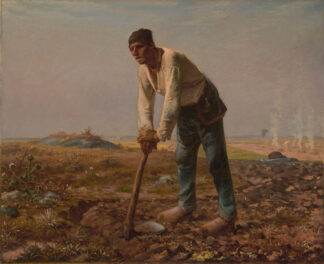
Questions New York-Moscow-New York, collaboration between Douglas Davis (right) and Komar & Melamid (left), 1977. Both signs ask, “Where is the Line Between Us?”
In a recent talk at the Getty Research Institute, artist Vitaly Komar described himself as a man of duality. Born in the USSR in 1943 and living in the U.S. since 1978, he identifies as half Russian and half American. He sees Russian culture as something between Asia and Europe, between Christianity and Islam. And most of his artistic career has been as half of a duo.
From the 1960s through 2003, Komar worked with artist Alex Melamid as the artistic duo Komar and Melamid. Together, they founded the Sots Art (Soviet Pop and Conceptual Art) movement in Russia, which co-opted the visual language of official Soviet state-sponsored art and propaganda.
In their work, Komar and Melamid often explored ideological and aesthetic dualities with the aim of uncovering the invisible lines that both join and divide humans. In their 1977 collaboration with artist Douglas Davis, Questions New York-Moscow-New York, a thick black line bisects photographs of the artists. From each side of the line, they hold signs that ask “Where is the line between us?” Here, the line becomes a symbol of the political division between Soviet Russia and the U.S. during the Cold War, but also asks us to consider ways that the two countries are bound to one another.

Skyscraper With Stalin Bust (from Anarchistic Synthesis series), 1986-87, Komar and Melamid. Tempera and oil on canvas, six panels, 107.5 X 48 in. overall
Such lines also appear in Komar and Melamid’s diptychs and polyptychs. The panels are painted in radically different styles—socialist realism in one, abstract expressionism in another. The result is a juxtaposition of styles and images that asks us to consider the nature of visual representation itself. In his talk, Komar said the lines between the panels join them in a dialogue about the ideologies these stylistic modes represent.
To Komar, even abstract images are allegories, as they conjure up stories and meanings from the past. For example, in Russia a black square evokes the Suprematism of Kasimir Malevich. In Russian, the word for “beautiful” is closely related to the word for “red,” which is heavy with meaning in communist ideology.
Komar took us back to his childhood to explain how a particular kind of duality was expressed in Soviet imagery. The Soviets banned avant-garde art, but also absorbed its elements for their own ends. This image from his elementary school is dominated by a giant head of Lenin in the style of socialist realism. But behind the head is a solid red triangle that evokes modernism—abstraction that co-exists with realism.

Example of a typical installation of the bust of Lenin in soviet schools.
In Russia, Komar reminded us, art was supposed to be made for the masses. But how did artists know what the masses wanted to see? When they came to the U.S., Komar and Melamid decided to ask. With the help of the Dia Art Foundation, they hired an ad agency to survey people around the world about what kind of colors, subjects, and styles they wanted to see. The result was the People’s Choice project (1994–1997). From the data (which is all available here), Komar and Melamid were able to create canvases that represent the most wanted (and unwanted) visual imagery for each country.
America’s Most Wanted is a realistic landscape of blue sky and blue lake featuring a figure of George Washington. Russia’s most wanted? A similar landscape of blue water and sky—but instead of George Washington, Jesus. And instead of adults at leisure, children at work.

America’s Most Wanted from the People’s Choice series, 1994, Komar and Melamid
In the least-wanted images from both the U.S. and Russia, we find more common ground: both countries deride abstract compositions of red triangles. In this project, Komar and Melamid managed to translate attitudes about taste and style into visual forms that characterize a nation. The result invites a conversation about what unites and divides these nations, and about the visual languages we use to communicate with one another.

Vitaly Komar inside the exhibition Deconstructing Perestroika at the Craft and Folk Art Museum in Los Angeles, on view through May 6, 2012




Vitaly sent us this work is his personal conclusion to the People’s Choice project: My Choice-Landscape With Lenin’s Tomb, 2007. More info